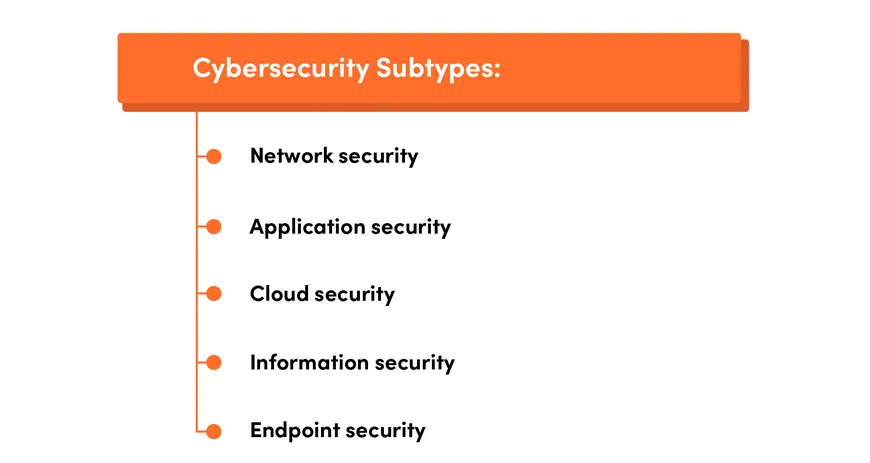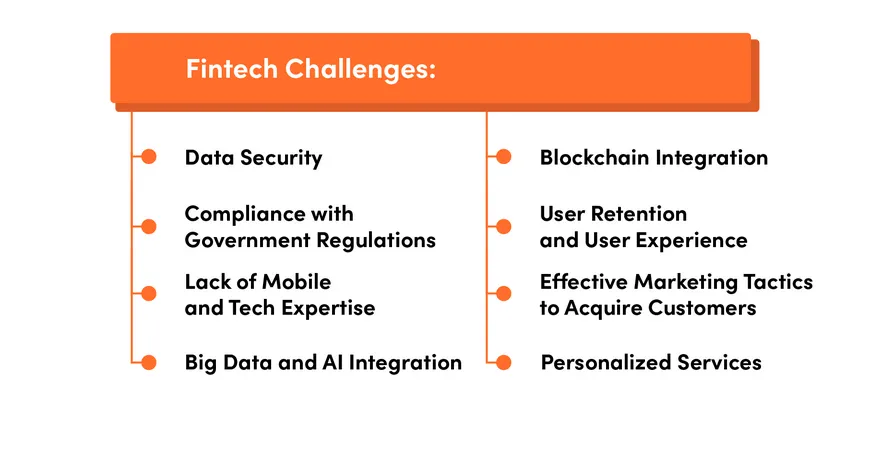Today's working environment is changing quickly, which entails that risks are increasing at the same rate. In this blog, we will look at the risks and difficulties that, if not managed properly, might jeopardize FinTechs' ability to fulfil their strategic goals for the year.
FinTechs should assess how these challenges may affect them and how they might sustainably limit that impact over the medium and long term. Let's get started!
In this article you will learn:
- How does compliance with regulations like GDPR and PCI DSS impact FinTech operations?
- Insider threats to FinTech cybersecurity and strategies can be employed to mitigate these threats?
- What role does AI fuzzing play in identifying vulnerabilities in FinTech applications?
- Challenges of integrating blockchain technology into FinTech systems and solutions which can address these challenges?
- Best practices for achieving scalability in FinTech applications.
What is Cybersecurity?

The area of cybersecurity involves safeguarding against loss, fraud, and unauthorized access to networks, devices, and data. Cybersecurity shields digital technology and the people who use them against digital threats, much as physical security protects buildings and the people who reside in them from numerous physical hazards.
A wide range of disciplines, behaviors, dangers, and concepts are covered under the broad issue of cybersecurity. However, the theme across all these sections is safeguarding people's digital lives and possessions. Protecting such important targets for criminals as digital currency, data, and access to particular systems is essential.
Consider all the many things that rely on data and digital technology nowadays. Since cybersecurity is a broad area, there are many different subtypes. Some examples are as follows:
- Network security: Defends against digital threats to computer networks such as those at home or those used by businesses.
- Application security: Helps to ensure that programs and applications deter hackers and maintain the privacy of users' data.
- Cloud security: Focuses on the cloud, where individuals and organizations store their data and operate web applications utilizing distant data centers.
- Information security: Focuses on protecting and maintaining the privacy of sensitive data.
- Endpoint security: Protects devices like desktops, smartphones, or Internet of Things (IoT) devices so they can't be used to access other devices or data on a network.
These are some of the most significant cybersecurity cases, although they are the only ones. As the field expands, many increasingly narrowly focused subcategories appear. An organization's overall cybersecurity is made up of all these minor factors.
Importance of Fintech Cybersecurity
Fintech businesses must prioritize security even if they are not subject to the same strict rules as their legacy banking competitors. A potential way for fintech companies to reduce their risk in the digital environment is through proactive cybersecurity services like pen testing.
Here are some of the main advantages of fintech cybersecurity that we should analyze in more detail.
Compliance

Although numerous well-known compliance frameworks spring to mind, such as GDPR or PCI DSS, financial service providers have more regulatory obligations than their counterparts in other sectors. For instance, the PCI DSS mandates the installation of intrusion detection systems by financial organizations to stop intrusions from propagating or going unnoticed.
Given the increased compliance standards for financial service providers, it becomes important to consider a cybersecurity plan to safeguard your company in line with these standards.
Fintech Data Protection
Even though PCI DSS is primarily concerned with data protection, it is not the only compliance framework or legal provision addressing the issue.
For instance, the Gramm-Leach-Bliley Act (GLBA) of 1999 mandates certain data security requirements for financial data. While the improved protection against customer data breaches provided by these higher requirements is reassuring, it also necessitates additional security-related spending on the part of companies managing this kind of data.
Reputation
The reputation of financial organizations is also a responsibility. A brand's reputation is rarely more at risk than in the event of a cyberattack that compromises information about customers or financial assets.
In addition, companies that provide financial services to their customers must build and keep their clients' confidence. The safety of client data and financial transactions is a key element of this.
Try our developers.
Free for 2 weeks.
No risk. Just results. Get a feel for our process, speed, and quality — work with our developers for a trial sprint and see why global companies choose Selleo.
Fintech Risks

Although apps are the public face of Fintech, APIs enable its brilliance and are the main target of many contemporary hacks. The majority of the risks to cybersecurity listed below have a direct impact on API security.
Data Breaches
Fintech applications are incredibly rich in personal and financial data, including credit card and bank account numbers, addresses, and responses to security questions.
Cybercriminals are interested in this confidential data because they may use it to attempt financial fraud or make money by providing it to others.
Determinate thieves use malware smuggling, phishing assaults, and open API endpoints without sufficient access restrictions to obtain the desired data.
Sadly, they are skilled at what they do and have successfully stolen millions of credit card numbers and account information from fintech startups and well-established businesses, including renowned organizations like Equifax and JP Morgan Chase.
Business logic issues are the most severe weakness because they allow users to utilize your application's legal functionality to access sensitive information. These problems must be found and fixed before cybercriminals have an opportunity to capitalize on them.
Since you need to create a unique test for each potential method the API could be exploited, they are also incredibly time-consuming and challenging to test manually.
AI Fuzzing
You've probably noticed a theme in our list: cyberattackers look for errors and vulnerabilities they can exploit and use to steal user data and identities.
Hackers find errors through a method called "fuzzing" or "fuzz testing." This testing technique feeds applications or APIS invalid, unexpected, or random data. The program is then monitored for exceptions such as crashes, failing built-in code assertions, or potential memory leaks.
Previously, fuzzing was a labor-intensive, tedious procedure that provided security teams the opportunity to identify and patch flaws before hackers could exploit them.
Cybercriminals are now actively employing AI and machine intelligence to streamline the fuzzing process to find zero-day weaknesses, particularly in APIs.
Reduce the quantity of information that servers utilize to respond to lessen the potential for data breaches. You may lessen the possibility that private information will end up in the hands of hackers by employing the very minimum amount of data required, random testing, and filtering.
Identity Theft

Cybercriminals utilize stolen or breached login credentials to mimic users and get access to accounts on fintech applications. This gives them the ability to steal money as well as sensitive personal data.
According to a 2021 worldwide study of financial institutions, account invasions have become a preferred target for hackers, with the number of attempted takeovers jumping by 282% between 2019 and 2020.
Attacks against APIs that affect authentication tokens and other account security measures are among the most frequent identity theft strategies.
Your security policy should include strong authorization and authentication measures to counter this risk and secure users.
Integration Loopholes
Apps are necessary for several common fintech functions to communicate with conventional banks, including mobile transfers. Integrating contemporary high-tech apps with the legacy systems frequently utilized by established financial institutions is a challenging technological task.
The solution often calls for several customized APIs, which presents many possible security holes. Without comprehensive testing and extraordinary attention to detail, it's simple to create a gap that hackers may discover and take advantage of.
Regularly scan for vulnerabilities to ensure exposed API endpoints are safe from exploitation. Do this after every modification to the source code, even the smallest ones, because fixing one weakness could expose another elsewhere.
DDoS Attacks
Hackers try to crash an app by flooding it with traffic during a DDoS (distributed denial of service) attack, hoping to accomplish so by forcing a security breach.
Unfortunately, many APIs that support fintech applications lack the rate-limiting or resource limitations necessary to prevent these focused assaults. This makes DDoS assaults a significant security issue for many fintech apps.
Rate restriction limits the quantity and/or frequency of requests that a specific user or IP address is permitted to submit over a specific period. Enforcing this limitation will aid your ability to fend off DDoS attacks.
Read also: Why Is FinTech The Future Of Finance?
Insider Threats
"The chain is only as strong as its weakest link." Fintech cybersecurity is a particular use of this. According to reports, internal threats, or risks from personnel within the organization, are the main reason behind 60% of security breaches.
In a few rare instances, the threat is posed by an angry or dishonest employee who purposely destroys or discloses data.
However, the majority of the time, a straightforward error threatens your security. It might be a developer who made a code error that resulted in a security loophole or an employee who unintentionally grants hackers access to your system after falling for a phishing scheme.
It's a risk you can't afford to overlook either way.
Phishing Attacks
Since the unsophisticated "Nigerian prince" frauds of the early 2000s, phishing attempts have advanced considerably. 36% of data breaches include phishing, indicating that users have become smarter, but cybercriminals also have advanced.
The goal of contemporary phishing assaults is to deceive consumers into changing their passwords or providing financial information over the phone by impersonating banks, governments, business leaders, and other trustworthy organizations.
Phishing emails pose a serious security risk to financial apps and consumers since they are frequently hardly identifiable from authentic communications. The repercussions of a successful phishing assault are severe; if hackers get access to the system, they can install ransomware or other malware, lead to a data breach or trigger a large-scale identity theft.
Regulatory Compliance
Although not a cyber-security issue in and of itself, regulatory compliance is a problem. The fintech sector is tightly regulated and subject to several banking rules, data protection legislation, payment processing standards, investment laws, and industry-standard security processes.
It is challenging yet vital to keep up with and comply with all the rules. Regulators won't hack you or steal your data, but they will apply heavy fines if you have a data breach due to insufficient compliance or security measures.
To ensure you comply with cyber security and data privacy laws, consult with cyber security experts.
Challenges of Fintech

Numerous well-known Fintech businesses deal with challenges, including protracted funding cycles, unmet goals, and rising losses. These problems are also rather prevalent. And this happens because the leading lifecycle is not managed properly.
But the fintech sector also confronts several other significant difficulties every day. Let's discuss this.
Data Security
Whether it's mobile banking, payment applications, or Fintech in general, data security has emerged as one of the top issues in the internet community. As we all know, traditional banking institutions are convinced of their ability to keep their information safe and secure with security guards, CCTVs, vaults, and massive bulletproof doors.
However, things are not as simple as we may imagine regarding digital security. Users may be more affected by vulnerabilities since their money and data are at risk, making them much more subtle and perhaps more damaging.

Solution
The assistance of a Fintech app development company will help you create a high-level security app. The following elements may be included in the app to increase security:
- Two-factor authorization
- Biometric authentication
- Data encryption and obfuscation
- Real-time alerts and notifications
- Behavior analysis
Compliance with Government Regulations
Finance is one of the industries with the most regulations. Even if you use conventional Fintech software that does not utilize blockchain and other essential technologies, there will always be government intervention.
Solution
Ensure that the software complies with the law before using it or developing an application. If necessary, you may also employ a legal adviser to walk you through all the fundamental guidelines and policies. Make sure your legal staff is informed of the most recent government regulations before hitting the market so you can make the necessary changes immediately.
Lack of Mobile and Tech Expertise
Some financial institutions or banks operate in the fintech sector without having adequate or practical mobile banking services. Some banks attempt to mimic websites, but no one would choose a mobile application in this digital age. Everyone wants a simple and practical alternative to utilizing.
Consequently, apps that don't make the best use of mobile devices due to a lack of fintech mobile app development skills are not user-friendly. For instance, NFC chips, geolocation capabilities, fingerprint unlocking, and other features might not be advantageous to apps. With the help of these features and technology, a fintech bank can provide incredible experiences.
Solution
Your mobile must have the following features to enable users with fintech app development services:
- QR-code for Payments in public transport
- NFC chips in shops
- Automatic scanning of a credit card number with a lense
- Two-factor authentication with a fingerprint
This can be done using full integration with the hardware of devices.
Big Data and AI Integration
Accenture reports that 82% of US and 79% of bankers worldwide think AI will transform how banks collect data and engage with clients.
Big data and AI have, as we all know, influenced every organization. Organizations can gather personal information about users via big data, including social status, financial behavior, patterns, and in-app activities.
Banks need access to this information to provide high-risk banking services and determine credit ratings. The entire process of identifying fraud, doing a risk analysis, and managing transactions are automated by AI using big data.
Fintech companies must overcome several obstacles to using these technologies, though. They need knowledge and ongoing maintenance.
It will be challenging to incorporate the most recent technology into an established system if you already work in the banking sector. In addition to technological improvements, putting this into practice will require you and your customers to adapt and reorganize your organization.
Solution
You must use machine learning to train AI for big data and AI to work together. You will require a lot of data to train your algorithm for this. Most banking applications cannot handle and retrieve several data sets. Therefore, you may use a one-shot learning model to overcome this issue since it enables you to train your machine learning system on fewer quantities of data.
Blockchain Integration

The use of blockchain technology is seen in many fintech applications. Blockchain is viewed as an impractical solution by some businesses, but it is also seen as a potential improvement in data interchange by other businesses.
The use of a blockchain can increase the credibility of the Fintech sector. Because it enables you to monitor, track, and evaluate every stage of a transaction and shield against changes so that you can keep an eye on it at all times. Blockchain integration, however, is a difficult challenge for many financial organizations.
Banks and other financial organizations haven't quickly adopted the blockchain concept up until now. However, companies in the fintech industry are more likely to attempt to fundamentally alter the industry. However, since these institutions continue to be cautious about emerging technology, they should consider conventional banks and governments.
Solution
As it is well known, integrating blockchain technology is difficult. Make sure you follow all rules and laws set forth by the government when you put this into operation. Additionally, stay away from any limits placed on your mobile services by the government since they are still unwilling to permit widespread blockchain implementation.
User Retention and User Experience
One of the main problems for the financial sector is user experience and engagement. However, fintech software must strike a balance between security and user experience.
For example, you must provide a mobile banking service that is neither too challenging to use nor too simple to break.
Solution
You must ensure that the UI/UX component is safe and user-friendly while creating a fintech app. In addition, people are prepared to utilize two-factor authentication to access an app. However, they may become frustrated if they repeatedly ask for login information.
To provide a smooth user experience, you may also research your competitors and see what methods they employ.
Effective Marketing Tactics to Acquire Customers
Fintech companies typically lack an understanding of their target market, strategy, and specialization. Recently, Fintech businesses have struggled to overcome this obstacle because most people still utilize conventional banking services.
Solution
You must ensure that you are superior to your competitors if you want to improve your business and plans. And for that, you either have to spend a tonne of money, time, and resources on human resources to provide uninterrupted service to your clients, or you have to stick with the conventional banks.
Offering the greatest goods is not what your customers would anticipate in this cutthroat market. By letting people know what you have produced, you must promote yourself. Additionally, you need to develop a solid and efficient marketing plan that uses teamwork, advertising, and other tactics. This will not only help you become more well-known, but it will also help you increase brand recognition.
Personalized Services
For a long time, personalized services have been the fundamental and core component of banking. In today's context, personalization implies communicating with a user at the right moment and on their chosen channel, with a suitable answer to their specific demands.
Furthermore, clients are willing to accept Fintech as a financial wellness advisor. Many users may be confused by a vast range of options, and successful customization presents them with only the options that are relevant to them.
Solution
Fintech companies need to have detailed customer insights to overcome this obstacle. Fintech companies must also comprehend user behavior and gain knowledge of the user's social interactions, events, and health. By fostering trust with customers, you may accomplish this aim. The user's data must be protected and kept secure.
Scalability Issues
Managing Growth
Scalability is a critical factor for fintech applications as they must handle increasing numbers of users, transactions, and data without compromising performance. As fintech companies grow, they often face several challenges:
- Performance Bottlenecks: As user numbers and transaction volumes grow, systems may encounter performance issues, such as slow response times or system crashes. These bottlenecks can result from inadequate infrastructure, poorly optimized code, or inefficient database management.
- Downtime and Reliability: High availability is crucial for fintech applications. Downtime can lead to loss of revenue, customer dissatisfaction, and damage to reputation. Ensuring reliability under heavy load is a significant challenge.
- Resource Management: Efficiently managing computational resources is essential to ensure that applications can scale without excessive costs. This includes optimizing server usage, storage, and network resources.
Strategies for Scalable Development
To overcome scalability challenges, fintech developers can implement several strategies:
- Cloud Infrastructure: Leveraging cloud services, such as AWS, Google Cloud, or Azure, provides flexibility and scalability. Cloud platforms offer tools for automatic scaling, load balancing, and distributed computing, which can help manage growing demands seamlessly.
- Microservices Architecture: Adopting a microservices architecture allows applications to be broken down into smaller, independent services. This modular approach enables individual services to scale independently based on their specific requirements, enhancing overall scalability and fault tolerance.
- Database Optimization: Using scalable database solutions, such as NoSQL databases (e.g., MongoDB, Cassandra) or distributed SQL databases (e.g., CockroachDB), can help manage large volumes of data efficiently. Implementing database sharding and replication can also improve performance and reliability.
- Caching Mechanisms: Implementing caching strategies, such as in-memory caches (e.g., Redis, Memcached), can significantly reduce the load on databases by storing frequently accessed data in memory, resulting in faster response times and reduced latency.
- Load Balancing: Distributing incoming traffic across multiple servers using load balancers ensures that no single server becomes overwhelmed. This helps maintain consistent performance and availability during peak usage periods.
- Continuous Monitoring and Scaling: Regularly monitoring system performance and resource utilization allows for proactive scaling. Automated scaling policies can be set up to dynamically adjust resources based on current demand, ensuring optimal performance without manual intervention.
- Code Optimization: Writing efficient, scalable code is fundamental. This involves optimizing algorithms, reducing complexity, and minimizing resource consumption. Regular code reviews and performance testing can identify and address potential bottlenecks.
By implementing these strategies, fintech applications can effectively manage growth, ensuring they remain responsive, reliable, and capable of handling increasing demands without sacrificing performance or user experience.
Conclusion
In the FinTech sector, many obstacles still exist to overcome. Fintech businesses face difficulties as a result of regulations and other government initiatives. But if we want to shake up the financial sector, we must constantly strike a balance between embracing new technology and adhering to the established order.
However, adopting new trends and technology is difficult for conventional banks. Mobile technologies are impactful and handy for consumers while also assisting banks in operating more effectively. Therefore I think they will eventually be used much more frequently in the financial industry.
If you are considering developing a fintech app, you can contact Selleo, a well-known fintech app development company. We assist you in developing your ideal app with the needed features and functionalities that provide a flawless user experience. Contact us now.





